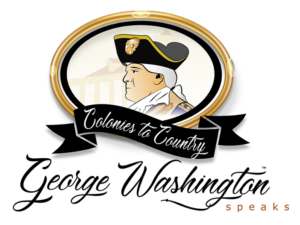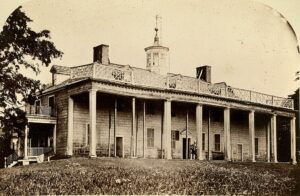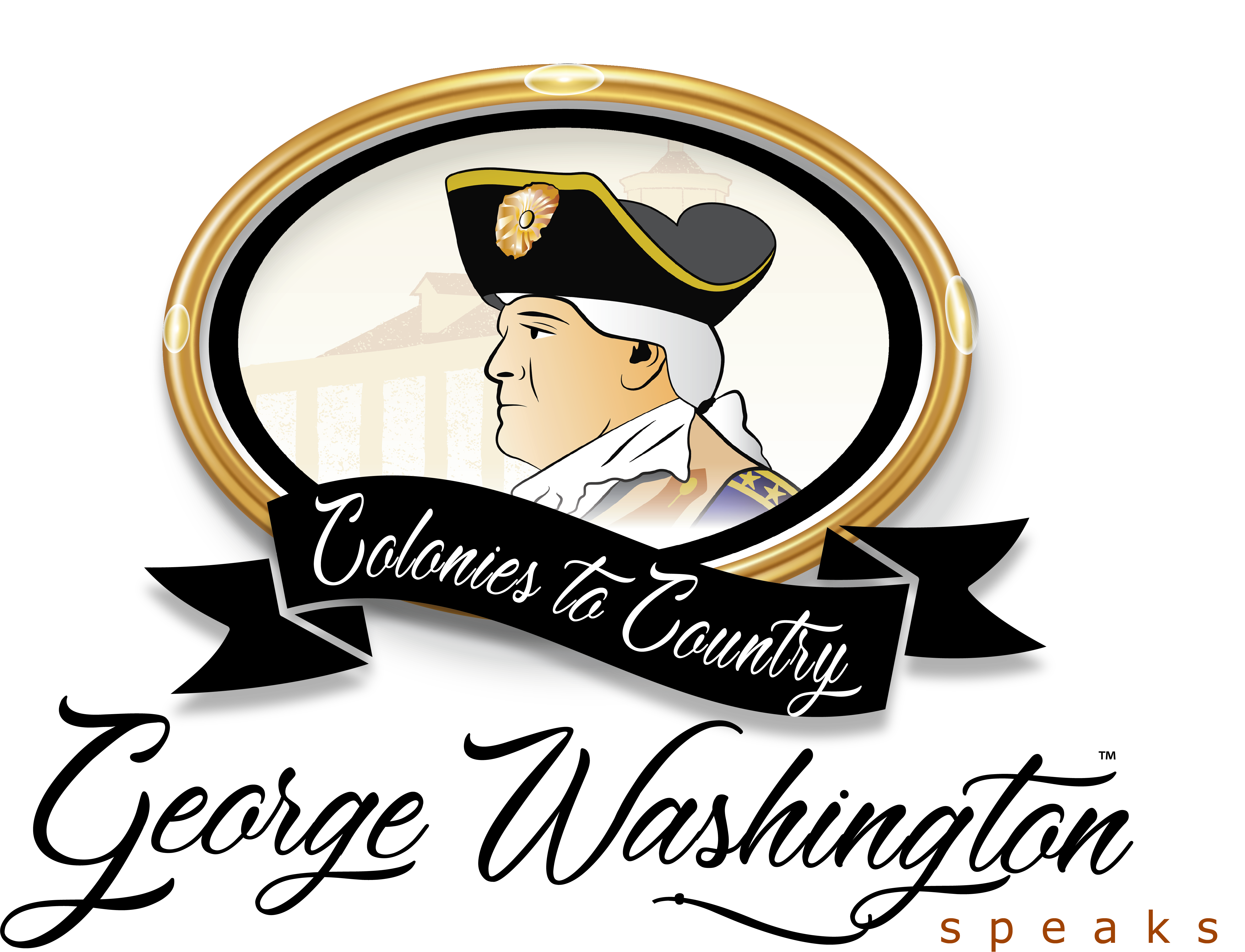
GEORGE WASHINGTON SPEAKS BLOG ARTICLES
OUR ARTICLES ARE CURRENT SO CHECK BACK AND KEEP UP ON OUR EVENTS AND NEWEST VIDEOS.
Last month I visited Fort Ticonderoga for their annual Seminar on the American Revolution. The visit took me far from my home in Washington State, to an area I’ve never seen before. The speakers included scholars, authors, graduate students, and historians. Each had a personal interest in a unique aspect of Revolutionary War history. But the fort itself was worth the visit.
A wartime fortress
![]()
Built first by the French, it came under the control of the English by the end of the French and Indian War. In May of 1775, Ethan Allen and Benedict Arnold led the Green Mountain Boys in a surprise attack that allowed the Americans to capture the fort.
Located on high ground above the southern reaches of Lake Champlain, the fort commands a wide view of the waterway. Cannon from the fort were hauled to Boston in the winter of 1775/76 and set up on Dorchester Heights under George Washington’s command, forcing the British to give up their stranglehold on Boston in March of 1776.
Meanwhile, American forces in northern New York continued to strengthen fortifications in the area of Fort Ticonderoga. But when a British force of 7,800 came south from Quebec in 1777 and hauled cannons to the top of nearby Mount Defia , the small American force could not defend the fort. They withdrew, leaving the fort in British hands again. By the fall of 1777, the British plan to control the Hudson Valley had failed with their defeat at Saratoga, and Fort Ticonderoga no longer had strategic value to them. The fort was abandoned before the end of 1777.
, the small American force could not defend the fort. They withdrew, leaving the fort in British hands again. By the fall of 1777, the British plan to control the Hudson Valley had failed with their defeat at Saratoga, and Fort Ticonderoga no longer had strategic value to them. The fort was abandoned before the end of 1777.
A restored ruin
After spending the weekend exploring the fort between seminar sessions, I was shocked to see an image of the fort from the mid-1800s, a total ruin. That image made the restored structures (an ongoing effort) all the more impressive.
![]()
George Washington visited the fort in 1783, which he mentioned in a letter to Elias Boudinot in mid-July, as a means of passing the time while awaiting the final treaty ending the war. An impressive sign at the entry to the fort today mentions him as one of many notable military figures who passed through the fort.
![]()
Contact me anytime at georgewashingtonspeaks@gmail.com.
I am your servant,
Vern Frykholm
WELCOME OUR GUEST STEPHANIE DRAY
We are delighted to welcome our guest, bestselling author Stephanie Dray, to the blog this month.
Washington in the Round: Exploring a Legend Through Fiction
by Stephanie Dray

Vern with Stephanie Dray (left) and co-author Laura Kamoie at the 2019 Historical Novel Society Conference in Maryland.
In the rich tapestry of American history, the persona of George Washington looms as a colossal figure. He’s on Mount Rushmore, the nation’s capital bears his name and is ornamented by a giant monument. But as with all the iconic figures of American history, the perception of this leader varies dramatically depending upon the lens through which he is viewed.
In times of continued racial tension, it is right to remember that he was a slaveholder. In times when presidential candidates talk about how we ought to have a president for life, it is right to remember that George Washington relinquished his power, refused to be king, and set in motion the democratic principles that have served our nation for more than two centuries.
But Washington doesn’t just look different depending on the angle from which we’re viewing him. He also looks different from the vantage point of his contemporaries.
In my novel, “America’s First Daughter” co-authored with Laura Kamoie, the American Revolution and the early years of the country are seen through the eyes of Martha “Patsy” Jefferson Randolph. For Patsy, her initial understanding of the American Revolution is deeply intertwined with the actions and beliefs of her father, Thomas Jefferson. George Washington, in this narrative, is a secondary figure, much overshadowed by the more direct influence of her father, especially his role in crafting the Declaration of Independence.
As Patsy matures, of course her perspective shifts. In the early years of the new nation, she more likely observed Washington not as a detached historical figure but through the lens of her father’s political struggles, particularly with Alexander Hamilton. Washington, from the point-of-view of the Jeffersons, emerges not as the unassailable hero of popular imagination but as a leader entangled in the complex web of early American politics, seemingly unable to rein in Hamilton’s influence.
In “My Dear Hamilton”, a different view of George Washington emerges, as seen through the eyes of Eliza Hamilton. For Eliza, Washington is a figure of deep reverence and admiration. The Hamiltons, and Eliza in particular, idolized him not only for his exemplary leadership but also for his integrity as a role model.
It is his character as a gentleman that deeply resonates with Eliza as he balances the heavy weight of the war upon his shoulders. He exudes a sense of honor, dignity, and a profound sense of duty. Their interactions are marked by Washington’s respectful and measured demeanor, a stark contrast to her much more intemperate husband, Alexander Hamilton.
However, a notable moment of tension arises when Washington refuses to grant Hamilton a military command, leading to a dramatic rift. Despite this, Eliza remains eager for reconciliation, her esteem for Washington undiminished. She sees him not only as the epitome of the American hero but also as a leader who embodies the values and aspirations of the new nation.
This multifaceted portrayal highlights Washington’s influence not only through his public deeds but also through his personal virtues. And Eliza perpetuated the legend of George Washington through her work on his national monument. As the musical says, she told his story. And she told it because she knew him personally.
The entwining of the personal and the political in forming an opinion about George Washington was even more evident when I was writing “The Women of Chateau Lafayette.” Through the eyes of the Lafayette family, particularly Gilbert du Motier, Marquis de Lafayette, and his wife Adrienne, Washington is a father figure–a mentor who provided guidance and inspiration during the Revolutionary Era. The couple even named their first son after him. This familial sentiment deeply influences how the Lafayettes live their lives, not to mention how they perceive Washington, framing him as a person of great significance beyond his public persona.
However, when Lafayette is imprisoned during the French Revolution, Adrienne’s frustration with Washington’s seemingly indifferent response to their plight seems justified. While historically, Washington was navigating a delicate balance of American interests, his lack of support for the Lafayettes during their time of need paints a picture of an emotionally cold leader caught in the throes of geopolitical pragmatism.
Which of these versions of Washington is the correct one? Perhaps all of them. But I look forward to seeing Washington through yet another set of eyes in our forthcoming novel “A Founding Mother” about Abigail Adams and her daughter Nabby.
BIO
STEPHANIE DRAY is a New York Times, Wall Street Journal & USA Today bestselling author of historical fiction. Her award-winning work has been translated into ten languages and tops lists for the most anticipated reads of the year. She lives in Maryland with her husband, cats, and history books.
www.StephanieDray.com
While most of my George Washington research falls in the non-fiction area, I do enjoy the fictionalized stories of our founding era. My wife and I have read all of Stephanie Dray’s novels of the period, and look forward to reading more. Vern
ANNIVERSARIES AHEAD! AMERICA’S 250th BIRTHDAY OFFERS TEN YEARS OF CELEBRATION
Movements are underway across the United States to celebrate the 250th anniversary of the signing of the Declaration of Independence. While the major focus is on July of 2026 for America’s birthday party, the celebrations have already begun. It started in Boston Last month, Boston hosted a celebration of the Boston Tea Party, an event in December of 1773 that lit a fuse for the revolution to come. (You can read about it in this Boston Herald article.) The tea was subject to a British tax imposed on the colonists, and they expressed their outrage by the “destruction of the tea” as the event was called at the time. In a letter to his friend George William Fairfax in June of 1774, George Washington wrote, “the Ministry [in England] may rely on it that Americans will never be tax’d without their own consent [and] that the cause of Boston … now is and ever will be considered as the cause of America.” Washington did not support the destruction of private property. In the same letter he said “not that we approve of their cond[uc]t in destroying the Tea.” So, while he supported Boston’s rejection of the unjust tax, he considered destruction of property the wrong approach against it. (View our short video about the tea destruction.)
Later this year you may see commemorations of the First Continental Congress, which brought together delegates from the American colonies in Philadelphia to work together rather than individually against Britain’s “intolerable acts” against the colonies. Washington’s military leadership begins In 2025, watch for reenactments and celebrations of the shot heard ‘round the world, the first armed engagement of British forces and colonial militia at Lexington and Concord, Massachusetts in April of 1775. Later that summer, George Washington was appointed Commander-in-Chief of the Continental Army, and went to Boston, the focus of conflict at the time.

The 250th anniversary of the Declaration of Independence will be the highlight of 2026, followed by a series of specific battle anniversaries and remembrances in the ensuing years. The French alliance will be celebrated for the critical support it offered the continental forces.
Success is in sight!
In 2031 we can expect celebrations of the decisive Battle of Yorktown, at which British General Cornwallis surrendered to the Continental Army. This is considered the final major battle of the war, although the Treaty of Paris wasn’t final until 1783—another opportunity for a 250th anniversary.
That will complete ten years of celebrating the success of the American Revolution. If you have ever wanted to participate in reenacting historical events, this would be a great time to get involved. Your friend Google can help you find reenacting groups in your area. George Washington Speaks will celebrate these events with new videos and presentations, and you can be part of it!
If you are interested in research, script writing for videos, portraying characters, or sharing other ideas, please contact me via email. I’ll be very interested to hear from you!
In whatever way you choose to participate, I look forward to celebrating America’s revolutionary history together.
HOME FOR THE HOLIDAYS
George Washington’s iconic home, Mount Vernon, wears out like any other home. For 45 years, George himself oversaw and expanded the Mansion. As a child, he had lived in the home his father built in 1734, which was gradually expanded to the house we know today. After passing through the hands of his brother, niece, and his widowed sister-in-law, George first leased and then inherited the estate.

Owned and operated by the Mount Vernon Ladies Association since they bought it in December of 1848, Mount Vernon requires constant maintenance and occasional major restorations and renovations. A significant project is under way now on the Mansion from 2023 to 2026. (Many outbuildings are also preserved on the estate.)
HVAC for preservation
In Washington’s day, his home relied on fireplaces, windows, and doors for heating and cooling. For the thousands of daily visitors to his home now, those sources are not adequate.
An underground utility bunker near the Mansion has been expanded to house updated heating, ventilation, and air conditioning equipment. This replaces a system installed in 1999 in the cellar. The older system prevented some areas of the cellar from regular inspection, and due to humidity, some structural elements have deteriorated. This damage can now be repaired, and the new system will provide climate control in the cellar for the first time. When the project is complete, more of the cellar will be accessible to visitors.
Drainage for the cellar
Many of us have lived in or known of homes with a damp cellar—or even flooding—due to rain and groundwater intrusion. Washington himself dealt with this, and the drains he installed in the cellar have been uncovered in the course of repair work.
Despite his early efforts, dampness in the cellar has continued to cause problems, so new, underfloor drains are being installed.
How did the Washingtons use their cellar? They stored food and supplies, a familiar use for today’s “basement” areas. The cellar also housed a kitchen for use by the enslaved household staff. And at least one staff member is believed to have lived in the cellar.
Framing and masonry repairs
Scientific study of the Mansion’s first-floor joists has determined the date of construction to be 1734, when Augustine Washington, George’s father, owned the estate. Moisture and termites caused damage to the wood framing, and by the late 1800s several localized areas were repaired. Unfortunately, the repairs did not always take into account overall structural issues, and a more comprehensive repair is now needed.

(Photo by Martin Falbisoner)
Can you imagine all you would need to remove from your home’s structure to reach and repair the wooden framework within? And to do all that without damage, so it could all be replaced when the work is finished? The Mount Vernon Ladies Association is devoted to preservation of the Mansion as it was when Washington lived there, and I’m thankful that craftsmen are available today with the skills to do that work.
As for masonry, the stone and brick components in the 18th century were softer than today’s, and the mortar used to hold them together was also a soft mortar. Modern “Portland cement” is much harder. Repairs made during the last century using modern cement have contributed to the deterioration of the original brick and stone elements. A historic soft mortar will be used to replace the hard mortar, bringing these structural elements into a more original state.
Christmas at Mount Vernon
The Washingtons celebrated Christmas with special foods and traditions, as many of us do. At Christmas in 1787, George surprised the household and guests by hiring a camel to be brought to Mount Vernon. This year, Aladdin the camel will amuse visitors to the estate from November 26 to January 6. Special seasonal activities include a candlelight mansion tour, chocolate making, fifing demonstrations of 18th century holiday music, and fresh baked gingerbread.
One Washington family holiday tradition you can follow at home is baking Martha’s Great Cake. The recipe is available at Mount Vernon’s website.
Visiting Mount Vernon during preservation
If you plan to visit Mount Vernon—which I highly recommend—be sure to consult their website so you know what to expect during this busy time of restoration. Some parts of the mansion must be closed to allow this work to take place. However, the estate has many other attractions and a wonderful museum.
George Washington is quoted as saying “I had rather be on my farm than be emperor of the world.” As Washington said in 1797, I now send you “the compliments of the season, and the return of many, many more, and happy ones.”

